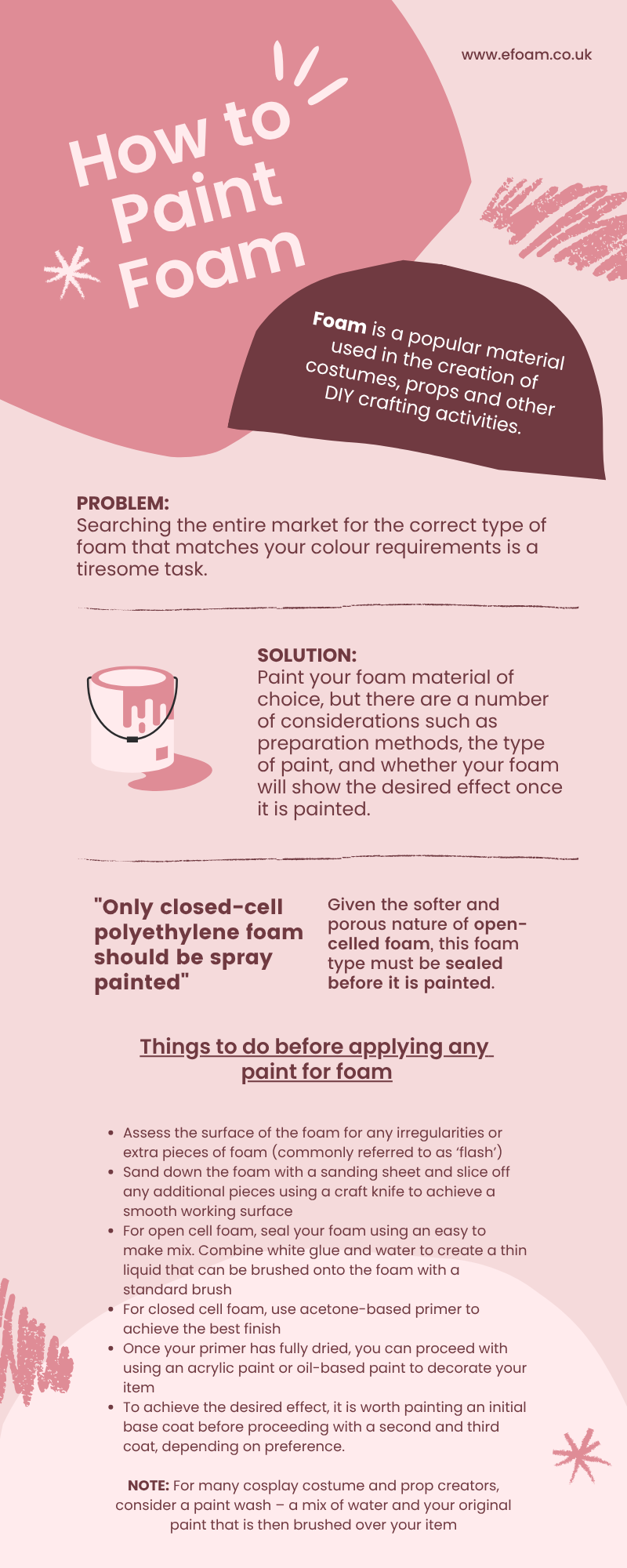
How to Paint Foam | DIY Paint Foam

Foam is a popular material used in the creation of costumes, props and other DIY crafting activities. Despite it being available in a number of colours, these options are often dependent on the type of foam selected. For example, certain grades like high-firm polyurethane are often only available in pale blue, and medium-density polyurethane in pale green. However, this can depend on the manufacturer.
Why use paint for foam projetcs?
When you’re looking to get stuck into your crafts, searching the entire market for the correct type of foam that matches your colour requirements is a tiresome task. An alternative is to paint your foam material of choice, but there are a number of considerations. These include the preparation methods, the type of paint, and whether your foam will show the desired effect once it is painted. For example, it may be difficult to achieve your intended outcome if you’re looking to paint a black foam a white or light pale colour. Whether your foam is suitable for painting also depends on its intended application, but if it’s a costume or item that won’t be exposed to water or the elements, it should be safe to proceed.
What kind of paint can you use on foam?
Given the textured nature of polyurethane foams, you may think to spray paint your foam item. However, only closed-cell polyethylene foam should be spray painted as open-celled foams tend to melt when subjected to the pressure and composition of some aerosols. A more straightforward option is to smooth, seal and prime your foam item before using your paint. Given the softer and porous nature of open-celled foam, this foam type must be sealed before it is painted.
How do you seal foam before painting?
Shape and clean the foam from any debris or dust, patch any voids, then brush or roll on two or three very light coats of a foam-safe, water-based sealer such as diluted PVA glue, acrylic gesso, or polycrylic, letting each coat dry fully and scuff-sanding between coats.
Can you paint directly onto foam?
No, before applying any best paint for foam, you must adequately prepare your material.
- Step 1: Assess the surface of the foam for any irregularities or extra pieces of foam (commonly referred to as ‘flash’). Sand down the foam with a sanding sheet and slice off any additional pieces using a craft knife to achieve a smooth working surface. It is far easier to better prepare your material, rather than trying to correct it after painting!
- Step 2: Next, seal your foam using an easy to make mix. Combine white glue and water to create a thin liquid that can be brushed onto the foam with a standard brush. Given this is only a necessary step for open-celled foams, you may decide it is unnecessary for your closed-cell foam components. However, for best results, we recommend using an acetone-based primer on your closed cell foam to achieve the best finish.
- Step 3: Once your primer has fully dried, you can proceed with using an acrylic paint or oil-based paint to decorate your item. To achieve the desired effect (particularly if wanting a single, bold colour), it is worth painting an initial base coat before proceeding with a second and third coat, depending on preference. To maintain the detailed texture of polyurethane foam, and to best control your design outcome, it is best to complete this step using a number of thin coats of paint, rather than one heavy coat.

Pro Tip: For many cosplay costume and prop creators, the design is in the detail. To achieve a specialist look or texture, you may want to consider a paint wash – a mix of water and your original paint that is then brushed over your item.
Our talented customer, Pippy, used this method for her foam costumes – as shown in the photo on the right. This can be useful for achieving a worn look, or when trying to recreate the appearance of stones or certain fabrics.
For advice on using and preparing foam for costume and prop making, please contact us.


